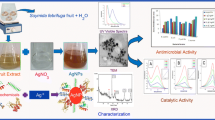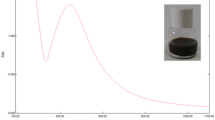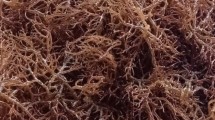Abstract
The silver nanoparticles (AgNPs) were prepared via a green synthesis method using guava fruit extract (Gfe) as a reducing agent and stabilizer. Factors affecting the synthesis such as temperature and Gfe volume were studied. The interactions between the synthesized AgNPs and Gfe were confirmed by the Fourier-transform infrared (FT–IR) measurement. The formation of AgNPs, for which the maximum surface plasmon absorption was observed at the wavelength of about 410 nm, was determined by the Ultraviolet–Visible (UV–Vis) spectroscopy. The transmission electron microscopy (TEM) analysis showed that the AgNPs had a spherical shape with an average diameter of 6.19 ± 2.44 nm at room temperature. In addition, the antibacterial properties of AgNPs against the Escherichia coli (E. coli) bacteria investigated using the disc diffusion and colony counting methods indicated that the synthesized AgNPs-Gfe inhibited the growth of E. coli with an excellent antibacterial activity of 99.99% at 5.6 × 106 CFU/ml of the initial E. coli concentration. This antibacterial activity of AgNPs-Gfe is much better than those of AgNPs–AA, and AgNPs–G (AA: Ascorbic Acid and G: Glucose). The AgNPs covered by organic compounds (tannin and flavonoid) have a high antioxidant activity and are good for health. These AgNPs-Gfe are, therefore, good candidates for biomedical applications.









Similar content being viewed by others
Data availability
Not applicable.
References
Ajitha B, Kumar Reddy YA, Reddy PS, Jeon H-J, Ahn CW (2016) Role of capping agents in controlling silver nanoparticles size, antibacterial activity and potential application as optical hydrogen peroxide sensor. 6: 36171–36179. https://doi.org/10.1039/C6RA03766F
Akintelu S, Folorunso A, Oyebamiji A, Erazua E (2019) Antibacterial potency of silver nanoparticles synthesized using Boerhaavia diffusa leaf extract as reductive and stabilizing agent. Inter J Pharm Sci Res 10:374–380
Alrasheid A, Eltilib S, Ahmed S, Mohamed A, Widatalla H, Yassin L, Ali M, Widdatallh M (2020) Green synthesis and antibacterial properties of silver nanoparticles using Sudanese Azadirachta indica leaves extract. Sci Res 8:14–19. https://doi.org/10.11648/j.sr.20200801.13
Aristri MA, Lubis MA, Iswanto AH, Fatriasari W, Sari RK, Antov P, Gajtanska M, Papadopoulos AN, Pizzi A (2021) Bio-based polyurethane resins derived from tannin: source, synthesis, characterisation, and application. 12. https://doi.org/10.3390/f12111516
Asmussen SV, Vallo CI (2018) Absorber materials based on polymer nanocomposites containing silver nanoparticles for solar thermal collectors. 174: 640-647. https://doi.org/10.1016/j.solener.2018.09.062
Bapat MS, Singh H, Shukla SK, Singh PP, Vo D-VN, Yadav A, Goyal A, Sharma A, Kumar D (2022) Evaluating green silver nanoparticles as prospective biopesticides: an environmental standpoint. 286: 131761. https://doi.org/10.1016/j.chemosphere.2021.131761
Barabadi H, Mojab F, Vahidi H, Marashi B, Talank N, Hosseini O, Saravanan M (2021) Green synthesis, characterization, antibacterial and biofilm inhibitory activity of silver nanoparticles compared to commercial silver nanoparticles. 129: 108647. https://doi.org/10.1016/j.inoche.2021.108647
Behravan M, Hossein PA, Naghizadeh A, Ziaee M, Mahdavi R, Mirzapour A (2018) Facile green synthesis of silver nanoparticles using Berberis vulgaris leaf and root aqueous extract and its antibacterial activity. Int J Biol Macromol 124:148–154. https://doi.org/10.1016/j.ijbiomac.2018.11.101
Bhagat M, Anand R, Datt R, Gupta V, Arya S (2019) Green synthesis of silver nanoparticles using aqueous extract of Rosa brunonii Lindl and their morphological, biological and photocatalytic characterizations. J Inorg Organomet Polym Mater 29:1039–1047. https://doi.org/10.1007/s10904-018-0994-5
Bose D, Chatterjee S (2016) Biogenic synthesis of silver nanoparticles using guava (Psidium guajava) leaf extract and its antibacterial activity against Pseudomonas aeruginosa. 6: 895–901. https://doi.org/10.1007/s13204-015-0496-5
Cuadrado-Silva CT, Pozo-Bayón MÁ, Osorio C (2017) Targeted Metabolomic Analysis of Polyphenols with Antioxidant Activity in Sour Guava (Psidium friedrichsthalianum Nied.) Fruit. 22: 11.
Das CGA, Kumar VG, Dhas TS, Karthick V, Govindaraju K, Joselin JM, Baalamurugan J (2020) Antibacterial activity of silver nanoparticles (biosynthesis): a short review on recent advances. 27: 101593. https://doi.org/10.1016/j.bcab.2020.101593
Ejikeme C, Stephen E, Eboatu A (2014) Determination of physical and phytochemical constituents of some tropical timbers indigenous to nigerdelta area of Nigeria. Euro Sci J 10:1857–7881
Ekwealor PA, Ugwu MC, Ezeobi I, Amalukwe G, Ugwu BC, Okezie U, Stanley C, Esimone C (2016) Antimicrobial evaluation of bacterial isolates from urine specimen of patients with complaints of urinary tract infections in Awka. Nigeria 2016:9740273. https://doi.org/10.1155/2016/9740273
Fahmy HM, Mosleh AM, Elghany AA, Shams-Eldin E, Abu Serea ES, Ali SA, Shalan AE (2019) Coated silver nanoparticles: synthesis, cytotoxicity, and optical properties. 9: 20118–20136. https://doi.org/10.1039/C9RA02907A
Farjadian F, Akbarizadeh AR, Tayebi L (2020) Synthesis of novel reducing agent for formation of metronidazole-capped silver nanoparticle and evaluating antibacterial efficiency in gram-positive and gram-negative bacteria. 6: e04747. https://doi.org/10.1016/j.heliyon.2020.e04747
Fernando I, Zhou Y (2019) Impact of pH on the stability, dissolution and aggregation kinetics of silver nanoparticles. 216: 297–305. https://doi.org/10.1016/j.chemosphere.2018.10.122
Firdaus M, Andriana S, Elvinawati AW, Swistoro E, Ruyani A, Sundaryono A (2017) Green synthesis of silver nanoparticles using Carica Papaya fruit extract under sunlight irradiation and their colorimetric detection of mercury ions. J Phys Conf Ser 817:012029. https://doi.org/10.1088/1742-6596/817/1/012029
Fraga-Corral M, García-Oliveira P, Pereira AG, Lourenço-Lopes C, Jimenez-Lopez C, Prieto MA, Simal-Gandara J (2020) Technological application of tannin-based extracts. 25. https://doi.org/10.3390/molecules25030614
Garcia PRAF, Prymak O, Grasmik V, Pappert K, Wlysses W, Otubo L, Epple M, Oliveira CLP (2020) An in situ SAXS investigation of the formation of silver nanoparticles and bimetallic silver–gold nanoparticles in controlled wet-chemical reduction synthesis. 2: 225–238. https://doi.org/10.1039/C9NA00569B
Gola D, kriti A, Bhatt N, Bajpai M, Singh A, Arya A, Chauhan N, Srivastava SK, Tyagi PK, Agrawal Y (2021) Silver nanoparticles for enhanced dye degradation. 4: 100132. https://doi.org/10.1016/j.crgsc.2021.100132
Gomathi M, Annamalai P, Rajkumar PV, Shanmugam R, Chandrasekaran R, Anbarasan P (2019) Green synthesis of silver nanoparticles using Gymnema sylvestre leaf extract and evaluation of its antibacterial activity. S Afr J Chem Eng 32:1–4. https://doi.org/10.1016/j.sajce.2019.11.005
Grasel F, Ferrao M, Wolf C (2015) Development of methodology for identification the nature of the polyphenolic extracts by FTIR associated with multivariate analysis. Spectrochim Acta A Mol Biomol Spectrosc. 153:94–101. https://doi.org/10.1016/j.saa.2015.08.020
Guimarães M, Silva F, Costa M, Oliveira H (2020) Green synthesis of silver nanoparticles using Ziziphus joazeiro leaf extract for production of antibacterial agents. Appl Nanosci 10:1073–1081. https://doi.org/10.1007/s13204-019-01181-4
Guntarti A, Hutami EN (2019) Validation and vitamin C testing in crystal guava (Psidium guajava L.) with variations of origin with the HPLC method (High Performance Liquid Chromatography). 11: 52–59.
Ibrahim EH, Kilany M, Ghramh HA, Khan KA, ul Islam S. (2019) Cellular proliferation/cytotoxicity and antimicrobial potentials of green synthesized silver nanoparticles (AgNPs) using Juniperus procera. 26: 1689–1694. https://doi.org/10.1016/j.sjbs.2018.08.014
Jebril S, Jenana R, Dridi C (2020) Green synthesis of silver nanoparticles using Melia azedarach leaf extract and their antifungal activities: In vitro and in vivo. Mater Chem Phys 248:122898. https://doi.org/10.1016/j.matchemphys.2020.122898
Kamaruzaman NH, Mohd Noor NN, Radin Mohamed RMS, Al-Gheethi A, Ponnusamy SK, Sharma A, Vo D-VN (2022) Applicability of bio-synthesized nanoparticles in fungal secondary metabolites products and plant extracts for eliminating antibiotic-resistant bacteria risks in non-clinical environments. 209: 112831. https://doi.org/10.1016/j.envres.2022.112831
Kannan B, Qing W, Wang Y, Liu X-H, Thayumanavan P, Wang Y, Ma F, Zhanga Y (2016) Antidiabetic activity of silver nanoparticles from green synthesis using Lonicera japonica leaf extract. RSC Adv 6:40162–40168. https://doi.org/10.1039/c5ra24391b
Kaur G, Kalia A, Sodhi HS (2020) Size controlled, time-efficient biosynthesis of silver nanoparticles from Pleurotus florida using ultra-violet, visible range, and microwave radiations. 50: 35–41. https://doi.org/10.1080/24701556.2019.1661466
Kumar B, Smita K, Cumbal L, Debut A (2017) Green synthesis of silver nanoparticles using Andean blackberry fruit extract. Saudi J Biol Sci. 24:45–50. https://doi.org/10.1016/j.sjbs.2015.09.006
Kumar SV, Bafana AP, Pawar P, Rahman A, Dahoumane SA, Jeffryes CS (2018) High conversion synthesis of <10 nm starch-stabilized silver nanoparticles using microwave technology. 8: 5106. https://doi.org/10.1038/s41598-018-23480-6
Laguta I, Stavinskaya O, Kazakova O, Fesenko T, Brychka S (2019) Green synthesis of silver nanoparticles using Stevia leaves extracts. Appl Nanosci 9:755–765. https://doi.org/10.1007/s13204-018-0680-5
Lokina S, Stephen A, Kaviyarasan V, Arulvasu C, Narayanan V (2015) Cytotoxicity and antimicrobial studies of silver nanoparticles synthesized using Psidium guajava L. Extract 45:426–432. https://doi.org/10.1080/15533174.2013.831881
Maharjan S, Liao K-S, Wang AJ, Zhu Z, McElhenny BP, Bao J, Curran SA (2020) Sol-gel synthesis of stabilized silver nanoparticles in an organosiloxane matrix and its optical nonlinearity. 532: 110610. https://doi.org/10.1016/j.chemphys.2019.110610
Makwana BA, Vyas DJ, Bhatt KD, Jain VK, Agrawal YK (2015) Highly stable antibacterial silver nanoparticles as selective fluorescent sensor for Fe3+ ions. 134: 73–80. https://doi.org/10.1016/j.saa.2014.05.044
Naseer S, Hussain S, Naeem N, Bhatti MP, Rahman M (2018) The phytochemistry and medicinal value of Psidium guajava (guava). Clin Phytoscience 4:1–8. https://doi.org/10.1186/s40816-018-0093-8
Nguyen TD, Nguyen DP, Hoang YH, Nguyen TT, Nguyen HT (2021) Rapid synthesis of silver nanoparticles using the extract of Psidium guajava leaf based on light-emitting diodes irradiation. 75: 5623-5631. https://doi.org/10.1007/s11696-021-01747-z
Parthiban E, Manivannan N, Ravichandran RNM (2018) Green synthesis of silver-nanoparticles from Annona reticulata leaves aqueous extract and its mosquito larvicidal and anti-microbial activity on human pathogens. Biotechnol Rep 21:e00297. https://doi.org/10.1016/j.btre.2018.e00297
Pazos-Ortiz E, Roque-Ruiz JH, Hinojos-Márquez EA, López-Esparza J, Donohué-Cornejo A, Cuevas-González JC, Espinosa-Cristóbal LF, Reyes-López SY (2017) Dose-dependent antimicrobial activity of silver nanoparticles on polycaprolactone fibers against gram-positive and gram-negative bacteria. 2017: 4752314. https://doi.org/10.1155/2017/4752314
Priya K, Vijayakumar M, Janani B (2020) Chitosan-mediated synthesis of biogenic silver nanoparticles (AgNPs), nanoparticle characterisation and in vitro assessment of anticancer activity in human hepatocellular carcinoma HepG2 cells. 149: 844–852. https://doi.org/10.1016/j.ijbiomac.2020.02.007
Priyadarshini S, Sulava S, Bhol R, Jena S (2019) Green synthesis of silver nanoparticles using Azadirachta Indica and Ocimum Sanctum leaf extract. Curr Sci 117: 1300–1307. https://doi.org/10.18520/cs/v117/i8/1300-1307
Ramesh PS, Kokila T, Geetha D (2015) Plant mediated green synthesis and antibacterial activity of silver nanoparticles using Emblica officinalis fruit extract. 142: 339-343. https://doi.org/10.1016/j.saa.2015.01.062
Rolim W, Pelegrino M, de Araujo Lima B, Ferraz L, Costa F, Bernardes J, Rodigues T, Brocchi M, Seabra A (2019) Green tea extract mediated biogenic synthesis of silver nanoparticles: characterization, cytotoxicity evaluation and antibacterial activity. Appl Surf Sci 463:66–74. https://doi.org/10.1016/j.apsusc.2018.08.203
Roy P, Das B, Mohanty A, Mohapatra S (2017) Green synthesis of silver nanoparticles using Azadirachta indica leaf extract and its antimicrobial study. Appl Nanosci.: 843–850. https://doi.org/10.1007/s13204-017-0621-8
Sajid PA, Chetty SS, Praneetha S, Murugan AV, Kumar Y, Periyasamy L (2016) One-pot microwave-assisted in situ reduction of Ag+ and Au3+ ions by Citrus limon extract and their carbon-dots based nanohybrids: a potential nano-bioprobe for cancer cellular imaging. 6: 103482–103490. https://doi.org/10.1039/C6RA24033J
Salleh A, Naomi R, Utami ND, Mohammad AW, Mahmoudi E, Mustafa N, Fauzi MB (2020) The potential of silver nanoparticles for antiviral and antibacterial applications: a mechanism of action. 10. https://doi.org/10.3390/nano10081566
Santos WNLd, da Silva Sauthier MC, dos Santos AMP, de Andrade Santana D, Almeida Azevedo RS, da Cruz Caldas J (2017) Simultaneous determination of 13 phenolic bioactive compounds in guava (Psidium guajava L.) by HPLC-PAD with evaluation using PCA and Neural Network Analysis (NNA). 133: 583–592. https://doi.org/10.1016/j.microc.2017.04.029
Singh H, Kumar A, Thakur A, Kumar P, Nguyen V-H, Vo D-VN, Sharma A, Kumar D (2020) One-pot synthesis of magnetite-ZnO nanocomposite and its photocatalytic activity. 63: 1097–1108. https://doi.org/10.1007/s11244-020-01278-z
Skiba M, Vorobyova V (2019) Synthesis of silver nanoparticles using orange peel extract prepared by plasmochemical extraction method and degradation of methylene blue under solar irradiation. Adv Mater Sci Eng 2019:1–8. https://doi.org/10.1155/2019/8306015
Sougandhi PR, Ramanaiah S (2020) Green synthesis and spectral characterization of silver nanoparticles from Psidium guajava leaf extract. 50: 1290-1294. https://doi.org/10.1080/24701556.2020.1745839
Taghizadeh S, Alimardani V, Lohrasbi P, Younes G, Kaviani E (2019) Gold nanoparticles application in liver cancer. Photodiagnosis Photodyn Ther 25:389–400. https://doi.org/10.1016/j.pdpdt.2019.01.027
Tang S, Zheng J (2018) Antibacterial activity of silver nanoparticles: structural effects. 7: 1701503. https://doi.org/10.1002/adhm.201701503
Thakur A, Kumar A, Kaya S, Vo D-VN, Sharma A (2022) Suppressing inhibitory compounds by nanomaterials for highly efficient biofuel production: a review. 312: 122934. https://doi.org/10.1016/j.fuel.2021.122934
Veerasamy R, Sethu V, Sivadasan S, Shah SA, Haris R (2016) Green synthesis of silver nanoparticles using Atrocarpus altilis leaf extract and the study of their antimicrobial and antioxidant activity. Mater Lett 180:264–267. https://doi.org/10.1016/j.matlet.2016.05.172
Veisi H, Mohammadi P (2018) Green synthesis of the silver nanoparticles mediated by Thymbra spicata extract and its application as a heterogeneous and recyclable nanocatalyst for catalytic reduction of a variety of dyes in water. J Clean Prod 170:1536–1543. https://doi.org/10.1016/j.jclepro.2017.09.265
Yaqoob AA, Umar K, Ibrahim MNM (2020) Silver nanoparticles: various methods of synthesis, size affecting factors and their potential applications–a review. 10: 1369–1378. https://doi.org/10.1007/s13204-020-01318-w
Zhang W, Jiang W (2020) Antioxidant and antibacterial chitosan film with tea polyphenols-mediated green synthesis silver nanoparticle via a novel one-pot method. 155: 1252-1261. https://doi.org/10.1016/j.ijbiomac.2019.11.093
Funding
The authors did not receive support from any organization for the submitted work.
Author information
Authors and Affiliations
Contributions
Conceptualization: Van-Phuc Dinh, Duy-Khoi Nguyen; data curation: Duy-Khoi Nguyen; formal analysis and investigation: Duy-Khoi Nguyen, Van-Phuc Dinh, N.Quang Hung; methodology: Van-Phuc Dinh, N.Quang Hung; supervision: Van-Phuc Dinh; writing—original draft: Duy-Khoi Nguyen, N.Quang Hung, Van-Phuc Dinh.
Corresponding author
Ethics declarations
Conflict of interests
There are no conflicts to declare.
Ethical approval
Not applicable.
Consent to participate
Not applicable.
Consent to publish
We declare that the information in this manuscript has not been published elsewhere nor is it under consideration by any other journal. Furthermore, it is the consensus of all authors to submit this manuscript for possible publication in ABAB.
Additional information
Publisher's Note
Springer Nature remains neutral with regard to jurisdictional claims in published maps and institutional affiliations.
Rights and permissions
About this article
Cite this article
Nguyen, DK., Hung, N.Q. & Dinh, VP. Antibacterial properties of silver nanoparticles greenly synthesized using guava fruit extract as a reducing agent and stabilizer. Appl Nanosci 13, 3709–3720 (2023). https://doi.org/10.1007/s13204-022-02506-6
Received:
Accepted:
Published:
Issue Date:
DOI: https://doi.org/10.1007/s13204-022-02506-6




